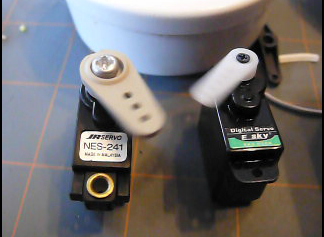Li-Po batteries have the best power/weight performance of all of the mini battery sizes. If only they'd come down in price more, they'd have more utility. In any case, I'm using small Zippy brand 11.1 volt (3S) 2200 mAh battery packs. The only problem I found is that the balancing connectors on them aren't nearly long enough to reach from my Turnigy charger to my bomb-proof charging container (an old army-surplus ammo case). I tried to see if anyone sold 3S lipo battery connector extensions, but no luck.
(SN).jpg)
Also, my Turnigy charger requires two connections for LiPo balancing -- the main Dean's connector and the balancing connector. This is a pain in the waddle since you can do it with only one connector -- as long as you remain within the relatively low amp constraits of the balancing connector (likely < 5 amp).
To make life difficult, there are apparently four (4) different LiPo balancing connectors in use. My Zippy batteries use the Align standard, which is a JST XH connector. Here's a very handy chart describing the various connectors and which batteries use which connector: http://www.rcaccessory.com/pdf/Battery%20Tap%20Configuration%20Guide.pdf
Now that I know that both my Turnigy charger and my Zippy batteries use JST XH, I just had to go to Digi-Key and order the right parts:
1 10 455-2249-ND CONN HEADER XH TOP 4POS 2.5MM JST XH SHROUDED HEADER 0 0.13500 $1.35
2 10 455-2267-ND CONN HOUSING 2.5MM 4POS JST XH HOUSING 0 0.05700 $0.57
3 100 455-2261-1-ND CONN TERM CRIMP XH 26-30AWG JST CRIMP CONNECTOR 0 0.03340 $3.34
4 10 455-2219-ND CONN HOUSING 2.5MM XH 3POS JST XH HOUSING 3 PIN 0 0.05700 $0.57
5 10 455-2248-ND CONN HEADER XH TOP 3POS 2.5MM JST XH HEADER 3 PIN 0 0.10000 $1.00
Once the connectors arrive, I'll have enough to play around with them for quite a while!
p.s. Bonus, the same connectors can also be used to create extensions for my LiPo battery monitors.

 I recently installed an Engine Block Heater (EBH) into my 2008 Prius -- just in time before this artic frigid weather struck New England. The part is a stock Prius Canada part that fits directly into American Prii without modification -- you don't even have to drain the antifreeze or remove an engine block plug like you do in other cars.
I recently installed an Engine Block Heater (EBH) into my 2008 Prius -- just in time before this artic frigid weather struck New England. The part is a stock Prius Canada part that fits directly into American Prii without modification -- you don't even have to drain the antifreeze or remove an engine block plug like you do in other cars.(SN).jpg)


Recent Comments